In this article:
Stretch marks are narrow, off-colored streaks that appear on the skin when it expands or contracts too quickly. Although commonly associated with pregnancy, these band-like striations can also form due to regular body growth or any kind of sudden change in the physique.
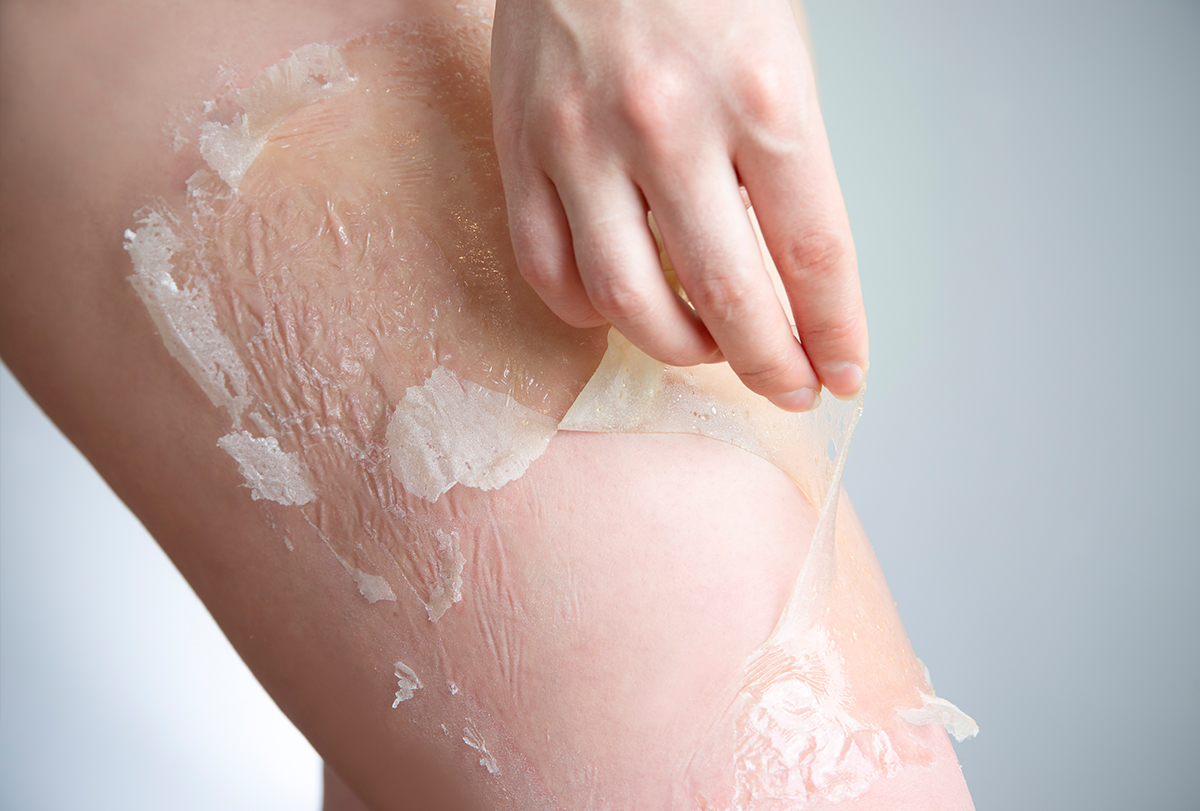
Stretch marks are typically considered a female concern because they are largely associated with pregnancy, but men can get stretch marks just as easily. This is particularly true of bodybuilders who develop these marks in areas where they form muscle.
Areas Prone to Stretch Marks
Stretch marks can appear anywhere on the body but they are more common in areas with high subcutaneous fat that are prone to stretching during weight gain. These include the abdominal wall, breasts, thighs, upper arms, buttocks, and lower back.
Appearance and Texture of Stretch Marks
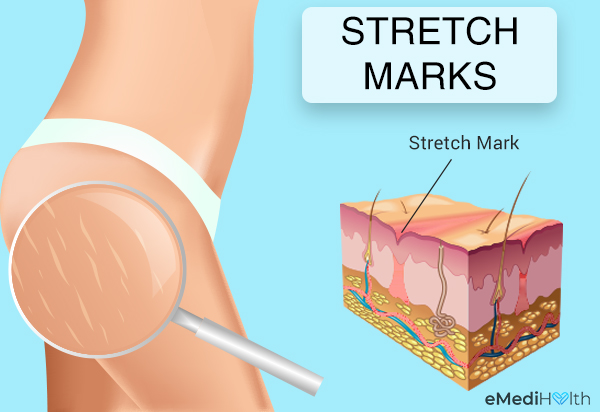
The stretched-out skin often becomes unusually pink, papery, and itchy even before the striations appear.
Texture: Once formed, stretch marks emerge as fine, shriveled streaks that are raised above the surrounding skin but flatten over time to become consistent with the rest of the skin.
Color: The internal tearing of the skin tissue exposes the blood vessels underneath, making the stretch marks appear pink, reddish-brown, or purplish when they first develop. However, this deep color eventually fades into a lighter silvery hue.
While the scarring usually becomes less conspicuous eventually, the stretch marks may never disappear completely.
Formation of Stretch Marks
There are three main skin layers. When the body grows at a faster rate than the skin does, the collagen and elastin are unable to keep up. When your skin overstretches, the connective fibers in the middle layers (dermis) tend to extend beyond their elastic capacity and snap under pressure.
As the skin tries to repair itself and recoil to its original shape, stretch marks form in the middle layers of the skin. They become visible as patches of parallel stripes or lightning bolts on the surface.
Causes of Stretch Marks
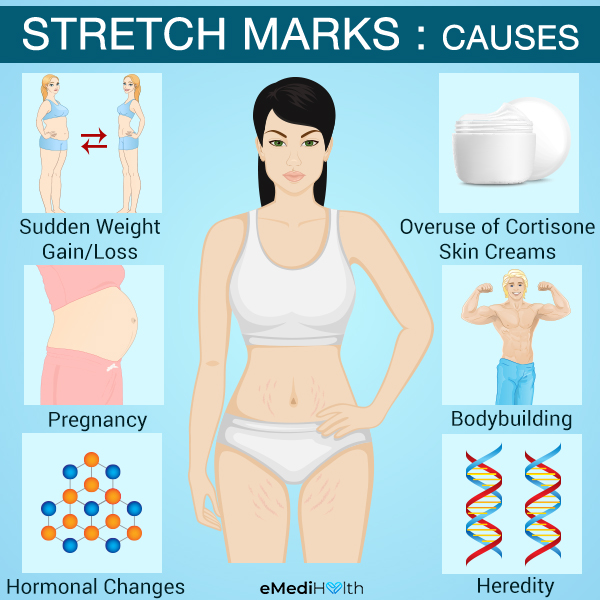
Many factors can trigger the appearance of stretch marks.
1. Sudden weight gain
Obese and overweight people usually have stretch marks on different parts of their body since their skin is unable to expand fast enough to accommodate their growing size.
Collagen and elastin are structural proteins that make your skin expand as the body grows but at their own measured pace.
If the body expands too much too quickly, the skin is pulled apart and the connective fibers in the dermis rupture, leading to the formation of stretch marks. This is why people who gain weight rapidly are more prone to getting stretch marks, as opposed to those who gain weight gradually.
2. Weight loss
Sudden weight loss can also cause stretch marks as the skin fails to shrink at the same pace as the body, leaving you with excess skin. As there isn’t enough surface area to accommodate the surplus skin, it can fold and compress other areas of the skin, resulting in stretching and tearing.
3. Bodybuilding
Bodybuilding exercises are designed to increase muscle mass. As the muscle grows, the skin over it often overstretches and tears to form stretch marks.
4. Overuse of cortisone skin creams
Excessive or prolonged use of topical corticosteroids can lead to skin atrophy or thinning, rendering it more vulnerable to tearing and scarring. The only way to reverse this damage is to discontinue the use of the cream as soon as the stretch marks appear, or else they may become permanent.
Taking high doses of oral corticosteroids for several months or longer can also trigger skin thinning and stretch marks.
5. Pregnancy
Stretch marks are a common occurrence during pregnancy when a woman’s body transforms in a matter of months.
As the childbearing body expands, the skin is pulled in different directions, resulting in tissue tearing that form stretch marks. Certain hormonal fluctuations can also contribute to this.
Up to 90% of all pregnant women develop stretch marks, usually in the third trimester, on the abdomen, thighs (inner and upper), and behind the knees. Certain women are more susceptible to getting stretch marks during pregnancy than others, such as:
- Those carrying multiple fetuses
- Those who were overweight before the pregnancy
- Those who conceived at a young age
ALSO READ: What Causes Pregnancy Stretch Marks and How to Avoid Them
6. Hormonal changes
During puberty and pregnancy, the production of cortisone hormone in the body increases. The elevated cortisone makes the skin retain more water and become less elastic. Moreover, the bonds between the collagen fibers weaken.
So, when the skin is stretched too much on account of the growing body, the collagen fibers break more easily and stretch marks emerge thereafter.
7. Heredity
People who have a family history of stretch marks are likely to get them as well, especially during pregnancy.
Genes may suppress the expression of the collagen and fibronectin genes. As a result, the skin is less elastic and more prone to tearing, resulting in the formation of stretch marks. The exact genetic mechanism that makes one prone to this condition needs further investigation to be clearly understood.
8. Other conditions
- Cushing syndrome is characterized by a heightened activity of the adrenal cortex, which leads to excessive production of cortisol hormone in the body. Increased amounts of cortisol can weaken the collagen fibers, thereby increasing the risk of skin tearing.
- Ehlers-Danlos syndrome is a disorder that can make the skin overstretched and prone to bruising.
- Patients with Marfan syndrome usually develop stretch marks on their shoulders, flank, and buttocks due to reduced collagen formation and weakening of the skin tissues.
- Certain medications that suppress collagen synthesis can make the skin less elastic and prone to tearing.
Medical Treatment for Stretch Marks
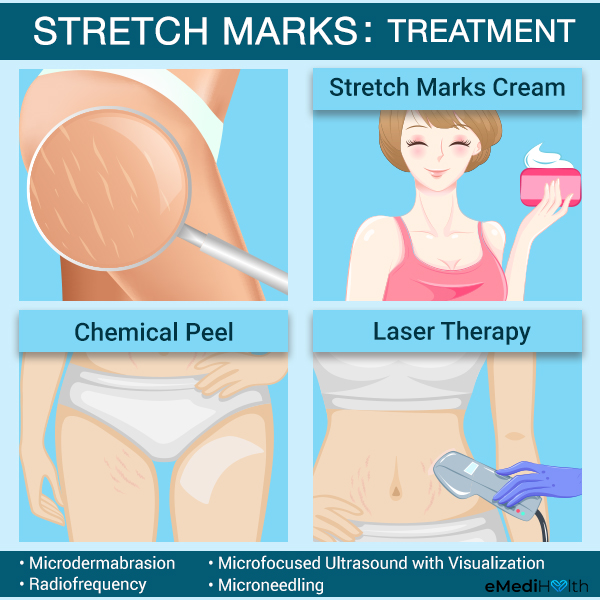
In most cases, stretch marks become less visible over time without any medical intervention.
However, if the scarring is extensive and appears on the commonly exposed areas of the skin, you may consider the following treatment methods to diminish the appearance of stretch marks. However, none of them guarantee complete scar removal.
Your skin specialist will determine the best treatment technique for your case after taking into account your age, overall health, and duration of the problem.
Note: If you are pregnant, be especially careful when deciding about a preventative treatment during pregnancy. Consult your ob-gyn before using any cream or ointment to avoid the occurrence of stretch marks. (1)
a. Topical treatments
Experts recommend prompt topical treatment of stretch marks as soon as they appear to minimize the extent of scarring but there is little to no scientific evidence to prove that this strategy actually works. (2)(3)
In fact, several commonly used topical products were found to be ineffective for preventing pregnancy-related stretch marks.
Nevertheless, some studies have highlighted the promising potential of specific interventions, such as a cream with Punica granatum and Croton lechleri resin extract. (4) Additionally, there are preventative treatments for stretch marks that are yet to be evaluated. (5)
Some of the standard topical treatments that can help reduce the degree of atrophic scarring associated with stretch marks include OTC cosmeceuticals, emollients, and silicone gels, as well as a relatively stronger vitamin A derivative called tretinoin, which is usually available on prescription and is not recommended for pregnant women.
Creams and lotions containing hyaluronic acid are deeply moisturizing and help repair or strengthen the skin by stimulating collagen production. This topical agent may help heal existing stretch marks and prevent new ones from forming when applied in a prescribed way. (1)(6)
Here are a few tips to get the best results from your topical treatment:
- Start using the product as soon as you notice the scar forming.
- Massage it gently into the skin with light circular motions to stimulate blood flow in the area, allowing better product absorption.
- Consistency is key if you want the topical therapy to bear fruit, so you must apply the product every day for several weeks at a stretch.
b. Dermatological procedures
The following cosmetic procedures can be performed by a dermatologist to make stretch marks less visible but they are unlikely to remove the scars completely.
1. Chemical peel
A chemical solution is applied to the affected skin to stimulate cell turnover in the area, which helps accelerate the shedding of the scarred skin. As the damaged skin peels off and is replaced by fresh layers, the appearance of the scar diminishes.
2. Laser therapy
A laser beam is focused onto the stretch marks to remove the dead and damaged skin tissue over multiple sessions. This relatively expensive clinical procedure is performed by a dermatologist or cosmetic surgeon.
3. Microdermabrasion
Microdermabrasion is a clinical procedure aimed at promoting new skin growth but without the use of chemical agents or invasive tools.
A concentrated spray of crystals is used to exfoliate the surface layer of the scarred skin. The light abrasive action of the crystals helps remove the dead skin cells and improve the overall appearance of the skin.
4. Radiofrequency
Radiofrequency devices may be used for tightening lax skin and increasing collagen production, both of which help diminish the appearance of stretch marks. (7)
5. Microfocused ultrasound with visualization
This procedure is regarded as a safe and effective treatment option for the improvement of skin elasticity, particularly in the face and neck and may even help with scar reduction. (8)
6. Microneedling
Tiny needles are used to remove dead epidermal layers and stimulate collagen synthesis for speedy skin regeneration. This professional skin exfoliation helps reduce the visibility of scars, including stretch marks.
7. Combination treatment
In many cases, dermatologists recommend a combination of therapies instead of just one. This gives you the best of what every technique has to offer, usually leading to fast and enhanced skin healing.
Before you proceed with any of the above-listed skin treatments, you must educate yourself about potential risks and side effects.
Note:
- You may experience minor skin irritation after undergoing most of these skin procedures. However, it will last only for a brief period and will resolve on its own.
- Your skin is delicate and needs to be handled gently and carefully. Make sure to get treatment only from trained skin professionals, such as board-certified dermatologists, to minimize the possibility of adverse reactions.
Diagnosing the Cause of Stretch Marks
Your doctor will recommend the appropriate treatment for stretch marks once the cause behind the scarring is identified. To get a clearer understanding of your skin condition, the doctor will:
- Inquire about your symptoms.
- Take into account your medical history.
- Physically examine the affected skin.
If this preliminary assessment fails to provide any definitive answers or insights, your doctor may order additional tests to reach the root of the problem.
Risk Factors
Stretch marks are most common in people who are undergoing a rapid phase of physical growth:
- Childbearing women usually develop them on their abdomen and breasts.
- Adolescents tend to get them on their thighs, breasts, and buttocks. Nearly 70% of girls and 40% of boys develop stretch marks during their teenage years.
- Bodybuilders or weight lifters usually build muscle mass on their shoulders, where the stretch marks may occur.
When to See a Doctor
Consult with your doctor if the stretch marks:
- Cover an extensive part of the body
- Develop quickly or without any discernible cause
- Cause itchiness
Expert Answers (Q&A)
Answered by Dr. Dina Keen, MD (Dermatology)
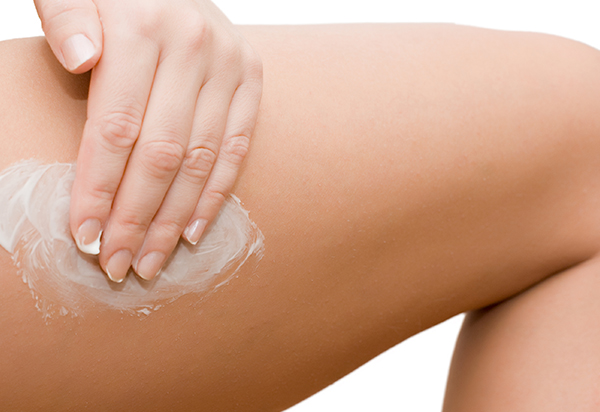
Yes. Sometimes when the cause of stretch marks is no longer present, the stretch marks can disappear on their own. However, in most cases, they just become less visible and fade over time.
Bitter almond oil as a base mixed with bitter orange oil, patchouli oil, neroli oil, pomegranate oil, or lemon oil may help reduce stretch marks.
Final Word
Stretch marks do not pose any danger to your health but having them can make you self-conscious. For some people, they can be a source of anxiety and decreased confidence.
If that is the case for you, there are several treatments, self-care measures, and therapies that may help keep these scars from forming in the first place or reduce their appearance once formed. The sooner you address the problems, the better the results. However, there is no intervention that promises complete scar removal.
Speak with your doctor at length to know just what to expect from each treatment option and then decide accordingly. You may have to try several alternative treatments before you find the one that gives you the best results.

- Was this article helpful?
- YES, THANKS!NOT REALLY


